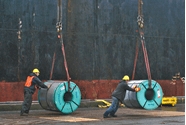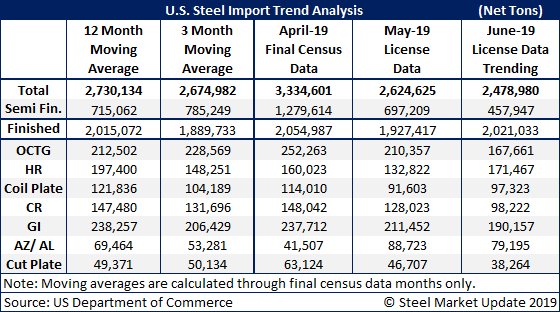Steel Products Prices North America

Foreign Imports Licenses Start Slow in June
Written by Brett Linton
June 11, 2019
This first estimate of U.S. steel imports for June shows foreign purchases trending further downward. The rate of Commerce Department import licenses, extrapolated out through the end of the month, forecasts total steel imports of less than 2.5 million tons in June, well below the average of around 2.7 million tons.
Steel imports spiked in April at 3.3 million tons in large part due to a big jump in imports of semi-finished products by domestic steel mills. Slab imports by U.S. steelmakers moderated to 697,000 tons in May, based on the preliminary estimate, and are on track to fall below 500,000 tons in June if the current trend persists. The Trump administration’s decision to remove the Section 232 tariffs on steel from Canada and Mexico effective May 20 does not appear to have opened the floodgates, as many had feared, at least not so far.
Easing in the pace of imports would tend to corroborate reports of softening demand in U.S. manufacturing.


Brett Linton
Read more from Brett LintonLatest in Steel Products Prices North America

Nucor slows HRC price climb with $5/ton increase
After eight weeks of double-digit price increases on hot-rolled (HR) coil, Nucor slowed the price rise this week with an increase of $5 per short ton.

Domestic CRC prices surge ahead of imports
The price spread between stateside-produced CR and imports reached its widest margin in over a year.

Evraz raises plate prices $160/ton
Evraz North America (NA) has followed Nucor and SSAB with a plate price increase of its own: up $160 per short ton (st). The increase was effective immediately for all new orders of carbon, high-strength low-alloy, and normalized and quenched-and-tempered plate products, as well as for hot-rolled coil, the steelmaker said in a letter to […]

Nucor lifts HR coil to $820/ton
Nucor has increased its consumer spot price (CSP) for hot-rolled (HR) coil for a fourth consecutive week.

Nucor pushes HR spot price to $790/ton
Nucor increased its consumer spot price (CSP) for hot-rolled (HR) coil to $790 per short ton (st) on Monday, Feb. 10 – a $15/st bump vs. last week. The Charlotte, N.C.-based company has raised its weekly CSP by $40/st over the past three weeks after maintaining tags at $750/st since Nov. 12, according to SMU’s […]
